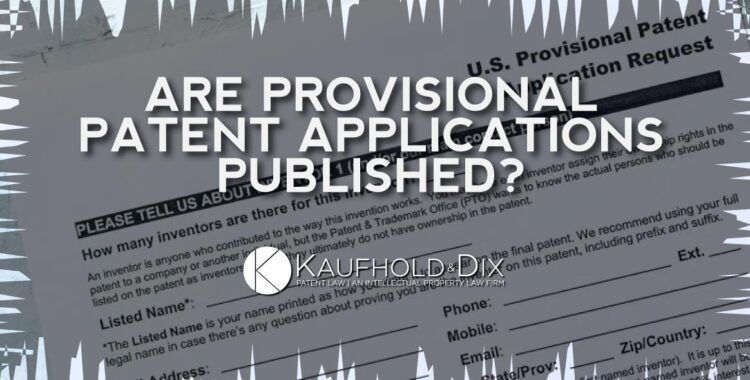Are Provisional Patent Applications Published?
Do you know that the U.S. Patent and Trademark Office issued over 370,000 patents in FY2019 alone? This is on top of the 10,000,000 that they have previously issued over the last two centuries. These, along with non-provisional patent applications older than 18 months, are publicly searchable on the USPTO’s online database.
There are, however, two ways to obtain patent pending status without publication. One is to file a non-provisional application and request non-publication. The second is to file a provisional patent application (PPA). A PPA provides a filing date and patent pending status to applicants and typically allows them to obtain patent pending status at a lower cost. This type of patent application doesn’t require all of the filing documents, formal patent drawings, or a complete claim set, as found with a non-provisional application. Because of the reduced time commitment and lower government fees, the provisional application is usually a much more affordable, though time-sensitive option to obtain patent pending status.
Differentiating Provisional Patent Applications from Non-Provisional Patent Applications
It’s important to know that there are differences between provisional and non-provisional patent applications. While non-provisional patent applications are published after 18-months from their earliest priority date for public inspections, provisional patent applications are not published unless converted into a non provisional application and, hence not available through a public search. However, the non-provisional application is published and the 18 months is calculated from the date of the first application – whether that be a non-provisional or a provisional application.
When you file a non-provisional patent application, the U.S. Patent Office will publish it for public viewing whether or not it is allowed as an issued patent. Once published, you can view it by doing a patent search on the U.S. Patent Office website.
On the contrary, provisional patent applications are not examined by a USPTO Patent Examiner and remain in a patent pending status at the U.S. Patent Office for a period of 12-months. Once the 12-month period elapses, provisional patent applications are abandoned and never published. They, therefore, remain a secret at the U.S. patent office. However, there are a few exceptions to this secrecy, as discussed below.
Exemptions to Provisional Patent Applications Secrecy
The U.S. Patent Office never publishes provisional patent applications, making them unavailable for a patent search or public viewing. However, there are two particular instances when the provisional patent application becomes available to the public for inspection. A provisional patent application is available for download by the public if you file a non-provisional patent application claiming priority of the provisional patent application, whereby the non-provisional patent application is either:
- Granted as a patent or
- Published
However, the provisional patent application can only be viewed through a direct request to inspect the provisional patent application or download a copy via the USPTO public PAIR portal system.
Facts About PPAs
The introduction of provisional patent applications provided U.S. patent applicants a means to file a patent application for a lower cost to give them some time to determine if a non-provisional patent is worth the additional time and money. Some facts that you should know about provisional patent applications:
- PPAs have one-year, non-renewable pendency period before they expire, that is the provisional must be converted into a non-provisional application before the 12-month window expires or the filing date is lost
- You cannot extend a PPA; the 12 month period is a hard limit
- Provisional Patent Applications can only be used for utility applications and cannot be used for design applications
- The USPTO doesn’t examine provisional patent applications and only views its component parts to ensure that it is a complete filing
- The USPTO doesn’t publish provisional patent applications unless you claim it as a priority through a later-issued patent or a published non-provisional application
- In order to use the provisional patent application filing date for a subsequent non-provisional application, the provisional must be complete since any new matter added will void the filing date and therefore it is important that a professional patent attorney writes the provisional application – this is not something that a layperson can do correctly and can cause loss of all rights
Advantages of Filing Provisional Patent Application
The 12 months the provisional patent application remains pending at the U.S. Patent Office can provide you enough time to handle essential steps before filing for a non-provisional patent. Some of the things you can be doing during this time include:
- Experiment and perfect your design
- Search for financiers to support your invention
- Determine your marketing strategy and sales potential
- Consult with the necessary licensing bodies
Since the provisional patent application is not examined, it allows you to avoid prosecuting costs associated with filing a non-provisional application so that you can use your funds elsewhere to continue developing your invention.
Precautions When Filing a Provisional Patent Application
While the above benefits of buying time to explore the upside potential of an invention are irrefutable, filing a provisional patent application has its share of pitfalls that you need to know about.
First, the one-year limit cannot be extended. Once you file a PPA, the law requires you to file for a non-provisional patent within one year, failure to to do so will cause you lose the benefit of the filing date. Though a year may seem like a long time to work on an invention, those 12 months go by surprising quickly and if a non-provisional patent is desired, the attorney will need time to write it, thus decreasing the 12-month window to 10 months. For this reason, if it is known that a non-provisional application is wanted, it can be less expensive in the long run to skip the provisional application.
Second, when submitting your application, the PPA must fully describe all the information that will be needed for the subsequent non-provisional application. Any information added onto the non-provisional application will not benefit from the provisional application filing date. Should any public acts take place with the invention before the filing of the provisional application, there is a risk that the inventor will lose all rights if they cannot rely on the provisional application filing date. This is because of what is known as the one-year bar date, which requires a patent application to be filed within one year of making the invention public in any way. Loss of the provisional filing date due to an incomplete application could mean loss of the ability to file a non-provisional application. As a caution, it is always important to have a patent attorney write the provisional application as that person is best suited to know what makes a complete application and can develop a strategy for what will be needed in the later-filed non-provisional application.
Bottom Line
Since the process of protecting your rights is complicated, especially when it comes to filing dates and the amount of protection available, make sure you involve a patent attorney to help you with the process. The patent attorney will also help you with additional steps, such as carrying out a patent search to increase your chances of being successful in obtaining a patent for your invention.
Intellectual Property Playbook
An Entrepreneur's Guide To Patents, Trademarks, and Copyrights GET THE PLAYBOOK








